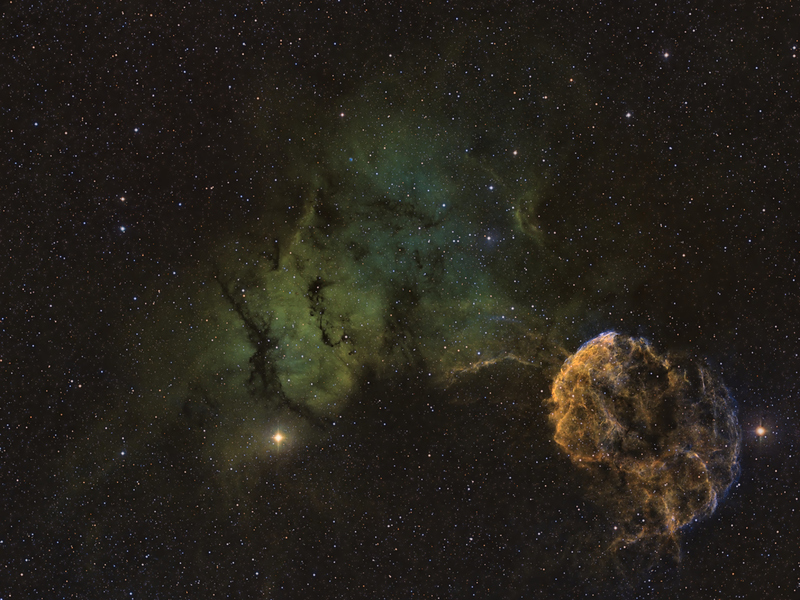Managed to grab several days on the trot before the awful weather set in. Taken on a Tak85 with reducer. I processed the nebula and stars separately and combined them with pixelmath, after removing the residual layer from my RGB star image.
That hint of Green really helps the depth of the image. I have found this works quite well…and although I dislike green in Astro images…it works to advantage on a wide field like this.
As for taking the stars out and then back in, I am not sure if this is causing the ‘blotchy’ effect when one looks closer. I am going to quote ‘RickS’ post on PI forum…this is a really good way to bring star colour into a NB image. As Rick says - not always just that easy…but worth playing with.
Quote:
“I usually add RGB stars to a NB image by extracting the L, a* and b* channels from each then using PixelMath and a star mask to blend the a* and b* from the RGB with the a* and b* from the NB image. Recombine the L, a* and b* for the NB image and voila! Sounds easy but there’s always a bit of messing around and tuning for any specific image. The advantage of this approach is that the original NB star profiles are preserved and only the colour is changed.”
Thanks for the honest feedback. I think you are right Kinch. I used to process it all together and patch in the RGB star color. I was pursuaded to separate out the stars but I have never been totally convinced. I find the morphological transformation tool leaves smooth dark holes where the stars were. It seems to pick up on the darkest pixel in the mask area and proliferate it. It was terrible with the noisier images and I had to alternate smoothing and reduction to stop it getting out of hand. This object is smack in the middle of the Milky Way so the gritty look is due to real stars, not noise. (images are taken before and after meridian flip, so a lot of noise is removed during integration)
The nice thing with PI projects and the history tool is that you can unpick it all and start down another track.
I am certainly not at this level of post processing…most of what you said has gone completely beyond my understanding. I’ll just patiently await your next image and continue to drool.
Scott
Scott - basically, if you use SGP to capture lots of data, you have many options on how to process. Narrowband images traditionally have weird colored stars. The secret is to capture some RGB images too, so that the stars are not saturated. The fun bit is combining them together.
Very pretty image! Congratulations.
@buzz I don’t think you have changed this image since I looked at it last, but I am now looking at it in better resolution on my desk-top monitor. I would have to take back what I said above - that remark about ‘blotchy’ background just does not apply to what I am looking at now.
It just goes to show - no matter how you present an image, everyone sees it differently depending on the quality of THEIR OWN equipment. Obviously my ‘cheap’ laptop (that I use for work related stuff) should be kept well away from Astro Images. (I even had to change out my own last image for this very reason.)
So - congrats - I now see a great image on screen here 
Kinch - there is some blotchiness around the stars, as a result of the star removal in the nebula. Very hard to get around but its presence is less significant after a subtle reduction in shadow contrast. If the monitor black-point is not calibrated (like my one at work), it is more obvious - but in a print to a good inkjet, using a dedicated paper profile, it completely goes away. I did try re-processing, without the star removal in the nebula, but so far I do not like the result.
It was in my face when I looked at the image on my laptop - here on this monitor, I have to go looking for it to see it. Most people don’t go that far in when looking at images but I guess some of us do - most especially on our own images.
I hope you keep trying without the star removal - in the end I think it gives a better result. The hard part though, is getting the star mask just right…….and sometimes that seems just about impossible 
I think I am going to include a small greyscale strip with my images in future. My own monitors at home are individually calibrated but I suspect many views are on monitors that are not. I try to avoid the plastic look that some noise reduction algorithms create and just leave the noise in the background, but dark enough so that you cannot perceive it.
If the monitor blackpoint and gamma are incorrect, the background is often much brighter and the noise then looks a mess.
